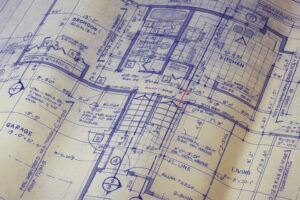
DOUBLE TAKES AT ASHBURN’S GROWING DATA CENTERS
Ashburn data centers have garnered more than a few eyebrow raises in recent years. Once a sleepy, rural town in Northern Virginia, it’s now known as Data Center Alley to many in the tech world, home to 139 data centers and counting, making it one of the most critical digital junctions in the world.
From cornfields to cables, Ashburn’s dramatic rise has been swift and expedient. This once-quiet corner of Loudoun County now handles more internet traffic than any other place on earth.
But what exactly positioned Ashburn to become the epicenter of global data traffic?
Let’s take a look! School’s in session.
From Farmland to Data Center Alley

FROM FARMLAND TO DATA CENTER ALLEY
Northern Virginia’s tech legacy runs deep and dates back to 1969, when the U.S. Department of Defense’s Advanced Research Projects Agency (ARPA) initiated the ARPANET project, establishing one of the first operational packet-switching networks.
In 1992, the establishment of the Metropolitan Area Exchange-East (MAE-East) in Vienna, Virginia, became a game changer. It was one of the earliest non-governmental Internet Exchange Points, and it practically set off everything, drawing major tech players to the region like bears to honey.
Enter Ashburn. Because of its proximity to Washington D.C., coupled with its ample land and minimal zoning headaches, the sleepy town became a magnet, and the dot-com boom of the late ‘90s solidified its future. Companies like AOL — you’ve got mail, remember that? — set up their headquarters in the area, and with high-capacity fiber lines already in place, the groundwork for what we now call Data Center Alley was in place.
Why Ashburn? Do Tell

WHY ASHBURN? DO TELL
Now there are several reasons why Ashburn data centers have become a mainstay:
Location
Location, location, location. It just makes sense. Situated only 30 miles outside Washington D.C., Ashburn’s location places it within striking distance of federal agencies, military contractors, and major corporate hubs — a seismic edge that benefits both national security and business.
Network Connectivity
Crisscrossing Loudoun County like so many sabre slashes, multiple redundant fiber-optic loops cover the area, allowing data centers to stay linked to each other and a nationwide web of infrastructure. Additionally, undersea cables linking the East Coast to international data centers make Ashburn data centers the backbone to deliver optimal global reach and reliability.
Land and Power
Unlike dense urban areas, Ashburn provided the open space and reasonably priced land ideal for building massive data center corridors. Equally important, Northern Virginia’s energy grid is engineered to handle the enormous electricity consumption these operations demand.
Business-Friendly Policies
Virginia rolled out the red carpet for data center developers by offering perks like tax breaks, infrastructure support, and simplifying zoning regulations. Most notably, the state’s exemption from sales and use tax on qualifying data center hardware has proven very attractive to technology firms and investors alike.
The Double-Edged Sword of Innovation
Now, yes, data centers have brought a flood of jobs and billions in tax revenue to Virginia, but they’ve also brought serious environmental challenges.
To begin with, keeping those massive server farms running 24/7 uses a ton of electricity. Just keeping the machines cool exhausts enormous amounts of energy. Add in backup power systems, lights, continual staffing, and it’s easy to see how the carbon footprint balloons quickly.
And then there’s the matter of e-waste. With each hardware upgrade comes a new dilemma: where does the old equipment go? It’s important when retiring IT equipment to safeguard data, recycle responsibly, and exercise the proper ethics to make sure innovation doesn’t come at the planet’s expense.
eAsset Solutions: The Green Answer
At eAsset Solutions, we make no bones about it: we believe in a ‘forever green recycle’ approach, one that promotes certified data destruction, responsible reuse and, of course, recycling.
As a leader in IT asset disposition, we specialize in secure data destruction and the responsible recycling of electronics.
Our core services include:
Certified Data Destruction:
Fully compliant with regulations like HIPAA and GDPR, among others, ensuring complete and auditable data erasure.
Environmental Compliance:
We adhere to R2v3 and RIOS standards to make sure everything is recycled safely and responsibly.
Circular Economy Support:
Functional components are refurbished and reintroduced to the market, extending timed-out hardware life and lowering resource waste.
By providing secure, regulation-compliant, and eco-conscious services, eAsset Solutions helps Ashburn’s digital infrastructure grow, and grow sustainably.
How the Circular Economy is Reshaping Data Centers in Ashburn
The data center lifecycle is relentless. With equipment typically turning over every 3 to 5 years, places like Ashburn see a constant turnaround of outdated servers and networking gear. Without real care and thoughtful disposal, the environmental fallout could be devastating.
Thankfully, the circular economy — a system of which we’re a huge proponent — is rewriting the narrative. Established on the principle of maximizing resource use and decreasing waste, it’s helping data centers rethink how they decommission old equipment.
Common approaches now include:
Reuse:
Restore and redeploy old tech where high performance isn’t essential.
Component Recovery:
Extract viable components and keep them in service longer.
Metal Extraction:
Reclaim valuable metals like gold, copper and other metals for reintegration into manufacturing.
By partnering with companies like eAsset Solutions, data centers reduce their ecological footprint and position themselves as leaders in go-green infrastructure.
Ashburn: The Original Blueprint

ASHBURN: THE ORIGINAL BLUEPRINT
Ashburn data centers have become the gold standard for data infrastructure. Its rise from rural town to tech heavy-weight is prompting leaders from Seoul to Stockholm to replicate the same.
But replicating the infrastructure is only part of the equation. Without integrating strategies for responsible growth — i.e. e-waste reduction, renewable energy sourcing, ITAD partnerships — these new and forthcoming ‘data alleys’ could inherit the same vulnerabilities Ashburn is now working to correct. The world isn’t just taking note of Ashburn’s success; it’s watching how it manages its maturity.
In so doing, cities must look to green strategies like those upheld by eAsset Solutions, where the forever green recycle philosophy bolsters innovation without environmental sacrifice.
Final Thoughts
Though Ashburn began as farmland on the fringes of Washington D.C., its butterfly-like transformation into a digital metropolis is a testament to daring innovation and calculated ambition. But as its influence grows, so does its obligation to lead responsibly.
While endless corridors of server racks hum and drone behind security walls, it’s the lesser-seen players — recyclers, engineers, policy-makers — who will help shape whether that momentum remains sustainable. The backbone of the internet may be invisible, but its impact is not.
With green, forward-thinking partnerships, and a vision firmly rooted in a forever green recycle commitment, Ashburn can prove that technological ambition and environmental responsibility don’t have to compete.
Contact eAsset Solutions to see how we can help your organization manage end-of-life electronics responsibly, securely, and sustainably. No ITAD project is too big for our team. From data center decommissioning to office upgrades and certified data destruction, our customized services support both environmental and regulatory commitments.











